
After the photo session where we played around with banners of fabric on the rooftops, we went to Times Square with the Modern Gypsies …
My assistant, Jessica, and I arrived ahead of them on purpose so we could set up the softbox on a monopod. Since we aimed at getting there during dusk, I knew we’d need off-camera lighting. The reason we wanted to do this at dusk, is so that we’d have both the massive neon displays light up .. and some remaining ambient light to avoid getting too many dark areas in the picture.
The lighting set-up was simple again. My assistant Jessica was going to follow me with the softbox – walking to my left, and a little ahead of me, but out of frame – while I photographed the group of performers.
We were going to photograph them as a group, and individually. I had my 24-70mm f2.8 lens on the one camera body. The speedlight on the camera was set to Master, and the speedlight on the Lastolite EZYBOX softbox, was set to Slave. A simple setup to shoot with wireless TTL flash.
Before they arrived, I got a basic exposure where there was enough detail in the sky and the surrounding buildings. With the neon signs flashing, and the evening light rapidly failing, I had to figure out an ambient exposure that would encompass all that.
Here is the same photo as above, but with the flash disabled, to give a sense of what was flash and what was ambient light.

1/200 @ f5.0 @ 800 ISO .. TTL flash, FEC +0.3EV
Nikon D3; Nikon 24-70mm f2.8 AF-S … at 24mm
using off camera flash on location with a softbox
It is in a scenario like this where TTL flash really shows its strength. With the thronging crowd we eventually had to move through, as well as the stilt-man’s erratic movements, we weren’t always sure of having the same distance between our light and the subject. This constant change in distance would’ve made manual flash a bit harder to work with. I needed the help of the TTL flash technology here in getting me close to correct exposure, since TTL flash is designed to give you correct exposure, even with changes in distance.
We expected a massive crowd around us …. and even the possibility of the cops shutting us down. This fortunately didn’t happen. Cool people.
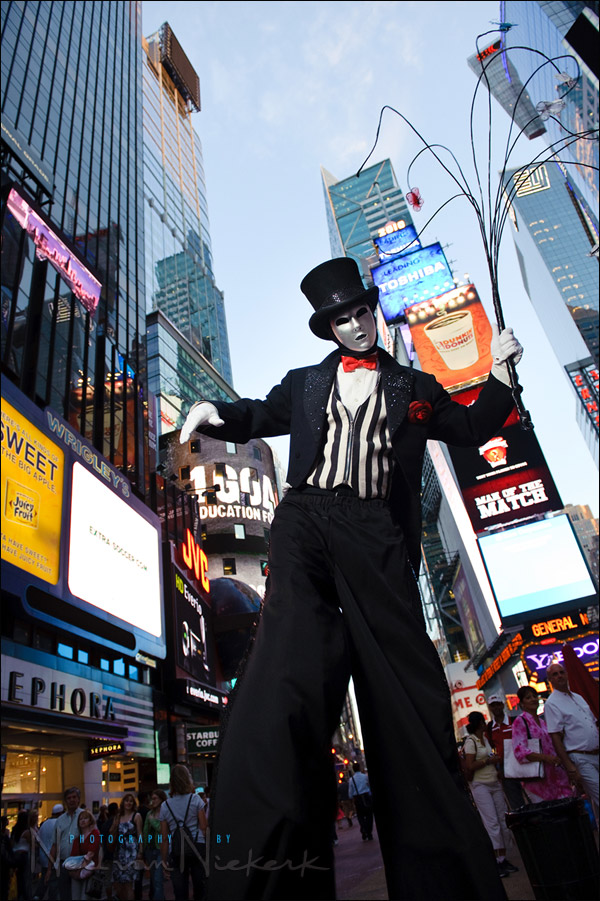
1/200 @ f4.0 @ 800 ISO .. TTL flash, FEC -0.3EV
Nikon D3; Nikon 24-70mm f2.8 AF-S … at 24mm
1/200 @ f4.0 @ 800 ISO .. TTL flash, FEC -0.3EV
Nikon D3; Nikon 24-70mm f2.8 AF-S … at 24mm

1/200 @ f4.0 @ 800 ISO .. TTL flash, FEC -0.3EV
Nikon D3; Nikon 24-70mm f2.8 AF-S … at 35mm
1/200 @ 3.5 @ 500 ISO .. TTL flash, FEC -1EV
Nikon D3; Nikon 70-200mm f2.8 AF-S … at 135mm
The technique used here with the photos in Times Square should be obvious and even self-explanatory by now if you look at the images. We find an exposure for the background that works for us … and then we add flash. How much flash? We let the technology help us out there on a fast-paced shoot by using TTL flash. Simplicity itself when the subject is darker than the surrounding areas in the photograph.
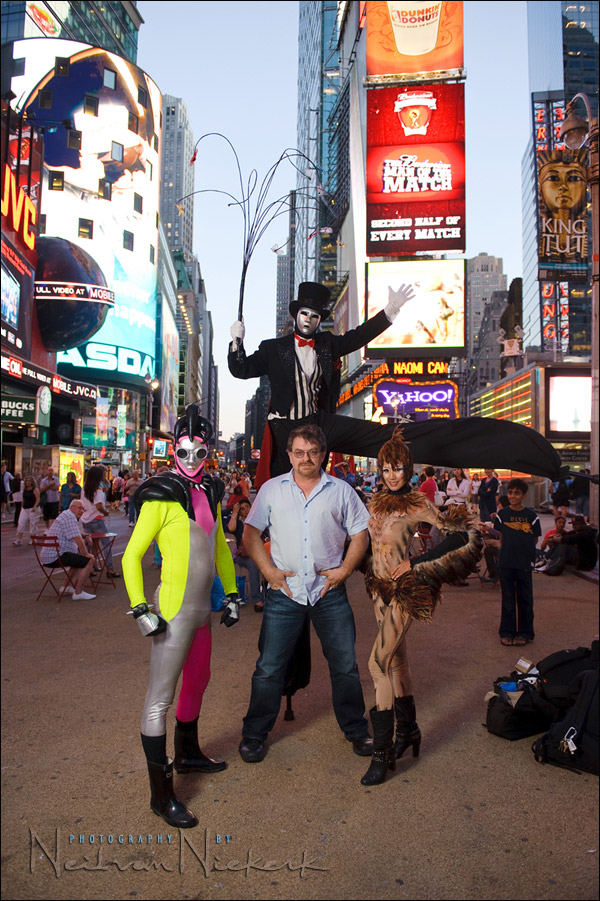
Thank you to the Modern Gypsies for … being other-wordly.
And a thank you to Jessica and Robert for helping out.
More articles on off-camera flash …
Equipment used during this photo session:
Nikon D3; Nikon 24-70mm f2.8 AF-S (B&H); Nikon SB-900 (B&H)
Lastolite EZYBOX 24×24 softbox (B&H)
Manfrotto 680B monopod (B&H);
brass stud to attach softbox to monopod (B&H)
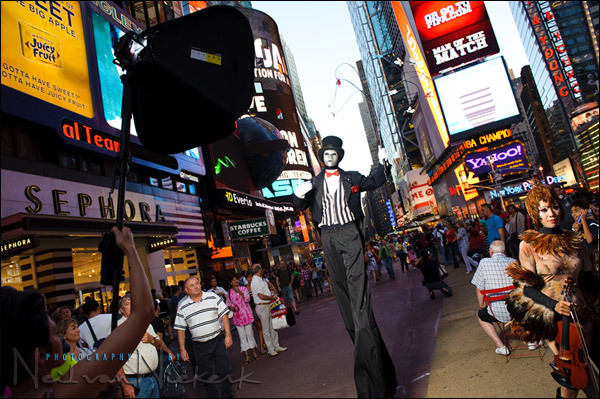
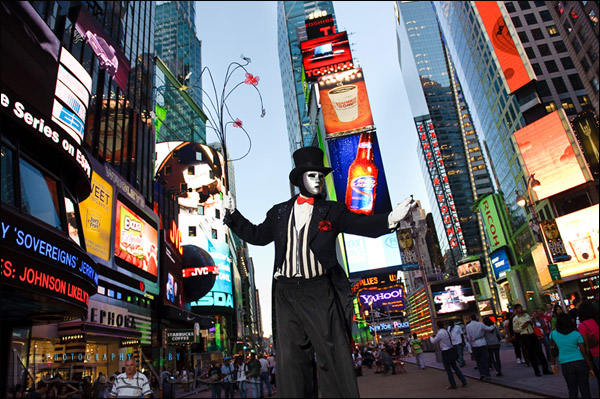
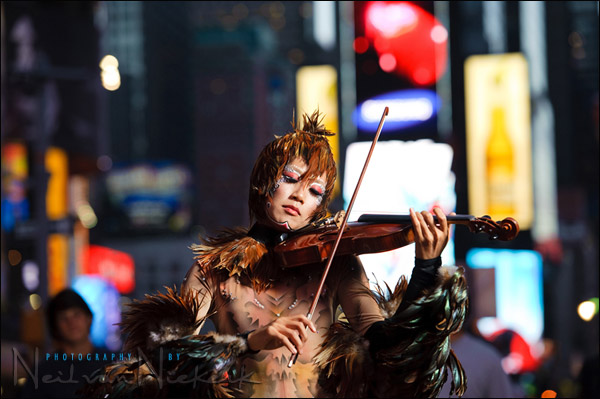
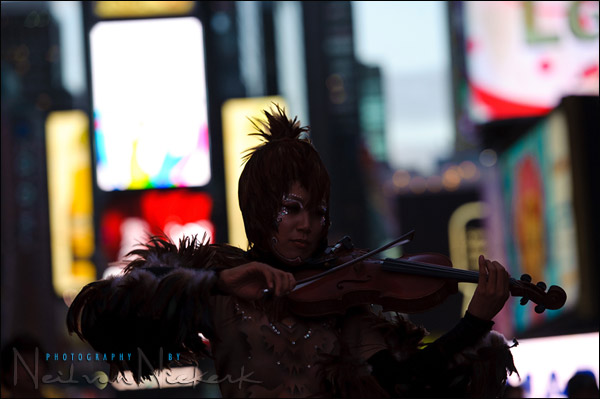
A great set of images as usual, comprehensively covering the picture taking process, especially with the inclusion of the pulled back shots showing light placement and distance to subject, and also the with, and without flash of the same set-ups. It’s great being able to see the direct comparison to see just how exactly the flash is contributing to the light. All very informative and useful.
How was the last photo made? (i.e. who is shooting the picture and holding the softbox?)
Also, do you generally need permits for shooting at public areas? Most of the general legal literature I’ve read says “No (with certain exceptions)” However, you recently mentioned that park rangers told you to leave a park you had no problems before, and then you were worried that Modern Gyspies troupe would cause crowd control problems. Do you have any insights to share with all your years of experience?
Neat, the Gypsies look like great subjects to work with.
Is it possible to make available the full flash portion of the EXIF data of these photos, as shown below, to help with the learning process? I’ve not been able to figure out why the EXIF for my shots taken with Nikon CLS Advanced Wireless all say “iTTL-BL”, when for this type of shot I would expect standard TTL. I’d love to see the EXIF data from a successful shoot to see how it compares to mine.
Aperture : 5.6
Shutter Speed : 1/60
ISO : 1600
Focal Length : 62.0 mm
Camera Model Name : NIKON D3S
Lens ID : AF-S Zoom-Nikkor 24-70mm f/2.8G ED
Focus Mode : AF-S
Metering Mode : Spot
Exposure Program : Aperture-priority AE
Exposure Compensation : -2
Flash : On, Return detected
Flash Mode : Fired, External
Flash Exposure Compensation : 0
Flash Sync Speed : 1/250 s (auto FP)
Flash Shutter Speed : 1/60 s
Flash Commander Mode : On
Flash Control Mode : iTTL-BL
Flash GN Distance : n/a
Flash Color Filter : None
Flash Group A Control Mode : iTTL-BL
Flash Group B Control Mode : Off
Flash Group C Control Mode : Off
Flash Group A Exposure Comp : +1.7
Flash Group B Exposure Comp : 0
Flash Group C Exposure Comp : 0
Hi Neil love this blog as i do all your work can i ask when using ttl, off camera whether bl or otherwise, is it crucial to have your light assistant on the same level as yourself. i know if your using on camera flash in ttl thats a constant can you even use ttl off camera? I think i kinda know the answer but it’s one of those questions i need to ask and put it to bed once and for all thanks in advance
Neil,
Thanks for the link to the Mayor’s Office of Film, Theater, and Broadcasting. Very informative reading.
As for my question about who was shooting you, my question was worded poorly. It looks like Jessica and Robert were the two people holding the camera and softbox to take the photo with you and the Modern Gypsies. I got confused who Robert was, since you arrived at the site with just Jessica. Sorry for my confusion.
Hi Neil
One interesting point raised above and something I can’t get a definite answer to is, does Nikon CLS use iTTL or iTTL-BL by default?
I’m not sure how, if at all this is linked to my question above, but more often than not when using CLS I recompose to place the subject off center in the frame. I know CLS takes its TTL reading from the center segment of the frame only, irrelevant of the subject placement or focus area selected, and I find that this results quite a lot in flash over-exposure of the subject. I assume this is the case as the center metering area for the flash is now metering the background beyond the subject distance and consequently pumping out more power.
According to basic literature included with the SB-800 etc. this is the exact reason to use FEL, where the subject is placed center frame, pre-flash FEL locks in the correct flash exposure, and then recompose and take the shot.
More often than not though, when using FEL the flash exposure is very different to the non use of FEL, and usually always a considerably brighter flash exposure with FEL. I’ve tried this extensively with 2 straight shots with the subject center, one with FEL and one without. I’m wondering would FEL possibly use iTTL, whereas non FEL might use iTTL-BL, taking the background brightness into account?
I do like the idea of FEL for 2 reasons, firstly it eliminates blinkers and secondly, provided the subject distance and lighting conditions doesn’t change then it should be consistent from shot to shot like manual flash while FEL is engaged.
Do you ever use FEL when using off-camera in TTL mode to allow for off centre subject placement, and if so do you or has anyone else experienced the inconsistent brighter flash exposure? Maybe there would be an amount of FEC that could be used as a starting point when using FEL to counteract the seeming flash over exposure.
Thanks
Nigel
Neil,
this is just getting better and better…. I’m really amazed at the quality of your latest work.
Thanks for sharing it with us!
Best P:)
Neil, seeing all of these wide angle shots is making me wonder if you have the new 24mm 1.4 yet? If so, I would love to hear what you think. Awesome work once again!
Nei,
What equipment you use to set off the TTL flash in the softbox?
-Ken
Greetings Neil
Like many of your devoted followers, and yes, you have many here down-under (Australia), I can say that I have learnt so much from your site. Together with this, my mentor, who is an award winning photographer (photojournalist), has helped me with flash.
.
I have a also downloaded a recommended e-book by Ed VEROSKY, titled “100% reliable flash photography”. I can say, that it is great and reinforces many of your principles.
.
My question is about a process he refers to as “STANDARDISATION” (yes, Australians spell it with an “S” and not a “Z” – ha ha). VEROSKY describes it as a process about “simplicity and consistency” in camera settings when working in different “environments” or “lighting conditions”.
.
I dont refer to camera values such as f-stops etc, because light varies worldwide, however what I concentrate on is why you chose to shoot in a certain way. For example, in one tangent (balancing flash with ambient exposure – where do even start) when refering to flat/even lighting, you like to underexpose the A/L by 1-2 stops.
.
In simple terms, how about a tangent on this topic (STANDARDISATION), and more so, have it divided into real world lighting conditions which we would experience. These being flat/even lighting, bright backgrounds, subject already well lit etc.
.
As mentioned, Im not looking at specific values, however would like to see your decision making process at work, and why. In this shoot, the model already had good light on her so I used fill flash – or, because the background was bright, I did this ……
.
I hope this makes sense.
Cheers
Angelo (Australia)
Angelo .. that kind of discussion .. my starting point in various situations, are discussed thoroughly in these two posts (and subsequent posts linked from there):
balancing flash with ambient light – where do I even start?
balancing flash with ambient exposure
It’s all there. In detail. And summary.
As always, great shots! I think the point about when you choose to shoot is critical. As you mentioned, shooting at dusk gave the right balance of ambient light so the signs are not overpowered by the sun and you got a great mix of sky, signs and then flash to pull the subjects up.
I’ve read and re-read most the whole site. The thing that impresses me is how much practical information I’ve picked up. When I grab my camera, I think about how to control the lighting and invariably I come back to something I read here.
I recently did some night shots in DC. They were family shots at various memorials. There were no magic numbers. instead, I had to be fluid and work to light the subjects, freeze the action, bring out the background ambient, keep the ISO down and still make some kind of pleasing composition. Whew!
Because we were outside, I had nothing to bounce off of nor did I have an assistant. So I mounted an SB-600 with a dome diffuser and a 1/4 CTO gel on my camera and pointed it straight ahead. An off camera softbox or umbrella would have been great but, IMO, you can do a lot even with straight on flash.
The real trick for me was getting enough flash to light everyone but keep the shot from looking “over flashed” I was between -2/3 and – 1 1/3 FEC most of the time with a wide aperture and ISO 2000. The metering was all seat of the pants. Mostly center weighted metering seasoned to taste after a test shot.
The key to clean high ISO (Nikon D300s) was nailing the exposure.
There were a few awful shots but there were also some great shots (read: not snapshots). IMO, a 1/4 or 1/2 CTO works really well at night in mixed artificial light. I set the WB to cool-tungsten-ish and I get great warm skin tones and don’t totally kill the color of the BG light.
This is a great site, very informative.
And this is a reason I should start experimenting with TTl, this is impossible if you put the body and the flash on ‘M’!
If you would add ND filters to it, to get the background less sharp, would everything else stay the same? It would be more difficult to get the camera to focus on the subjects probably because the sun is gone and the subjects move..
Wonderful info Neil!
Couple questions.
1)I’ve been tending to use two off camera SB-900 with the Ezybox’s to mimic a main light and fill light when doing on location photos, but most of your posts only shows you using one. Why the preference for one mostly.
2)I use the Nikon SU-800 as my commander on my D300s so I have access to my TTL values quickly. Is there a reason that you tend to use another SB-900 as the commander instead. Doesn’t this mean that you have to go into your menu settings all the time to adjust the FEC settings.
As a comment, I would love to have you do a blog on using the handheld Sekonic L-358 as a way to get your ambient exposure to start with. I’m useless with mine.
Thanks keep up the great work!
Hi Neil,
Love the article. I was wandering if you have used the quantum x5dr with all the additional power, 1’m thinking about getting one for the direct sunlight shoots, but can’t seem to find much on them. Thanks.